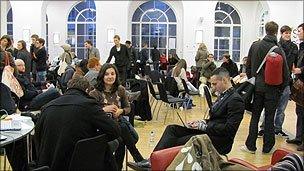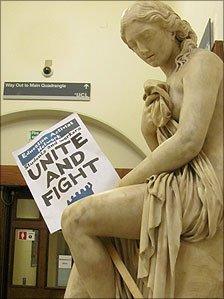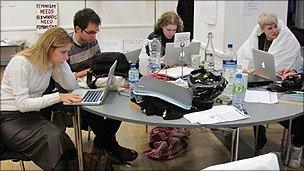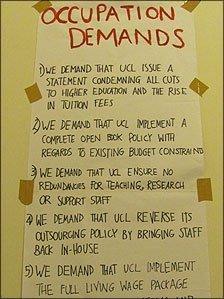What's it like inside a university occupation?
- Published

Students are calling on the university to join their campaign against cuts and fee increases
Students in University College London are into the seventh day of their occupation, part of the biggest wave of campus unrest for years.
The walls of the large room being occupied are covered in banners, slogans and messages of support.
Philosopher Noam Chomsky has sent his regards from the United States. Billy Bragg, whose albums are older than many of his audience, has put in an appearance.
A timeline of the occupation is being recorded in a series of wall posters.
A large projector screen shows a Twitter feed and the text of the latest letter from the university authorities is published. A "dance-off" against other students in other occupations has been posted on YouTube.
Stereotypes
These are well-dressed, articulate youngsters, there's no damage to the room, and the occupation leaflets are mixed up with sleeping bags and text books about biology and Spanish grammar.
This looks like a revolution that probably does the hoovering when it's finished. Any stereotypes about rent-a-rioter are way off the mark.

Students have been claiming the arrival of a "new politics"
But what's going on with these students? Weren't they meant to be the iPod generation, switched off from politics?
"We've taken all the things that were meant to characterise us as apathetic and used them as political tools," says Sofie Buckland, an English literature student.
She says she's a mature student, which in this gathering means she is 24.
"They said we do nothing but use social networking all day, but we're using Facebook to organise protests."
DIY radicalism
The plan to almost treble tuition fees to £9,000 per year has triggered these student protests - and much of the antagonism is towards the coalition government, with Deputy Prime Minister Nick Clegg becoming a particular lightning rod for their indignation.
The first demand of the occupation is that the university publicly condemns the plans to raise fees and cut budgets.
But there is something else going on here, some kind of generational changing of the guard.

Students have been using websites and Twitter in their campaign
The protests that took place last week weren't organised by any conventional political organisation, but they managed to mobilise youngsters in towns and cities from Bournemouth to Edinburgh.
It was run through social networking websites, with little centralised control.
This DIY radicalism has its own news channels, on Facebook pages and Twitter accounts and blogs, leaving the traditional news organisations and political commentators looking in from the outside.
Sofie Buckland says it's ushering in a "new politics", rejecting the arthritic manoeuvres of the mainstream political parties.
If the technology metaphor was stretched a little further, they seem to expect a much more interactive experience from their politics.
'Dark age'
A group of students returns to the occupation from a "flash mob" pavement protest, staged on Oxford Street on a bitterly cold afternoon.
Ben Beach says such 1960s-style "situationist" tactics and street protests are going to grow, predicting much bigger campaigns in the spring.
He says the plans for higher education, including the deep cuts to teaching budgets, represent a "dark age, a new philistinism".

The demands are headed by concerns about cuts and higher fees
As an architecture student, he'll be in his late twenties before he finishes training.
With the planned fee system proposing loan repayments to be paid back over 30 years, it would mean that people in his position in the future would be repaying student debts into their late fifties.
Outside the occupation there's a mocked-up coffin, symbolising education.
When you read the messages around this coffin you get a reminder that these are students born in the 1990s. They're quoting Harry Potter rather than Che Guevera.
It's the Hogwarts kids, with their strong sense of right and wrong, who are now putting up the barricades.
And they seem as distant from the old left as they do from the new right.
So far the university authorities have allowed the students to remain here. There's no real sense of confrontation. It's also worth remembering that while about 150 people might have taken part in the occupation, it's out of a total of 22,000 students.
The occupation is taking place in the Jeremy Bentham Room, named after the 19th Century radical. His body is kept in a glass case around the corner from where the students are holding their protests.
A different kind of radicalism, armed with a laptop, is taking shape.